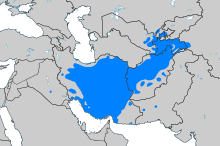ᱯᱷᱟᱨᱥᱤ ᱯᱟᱹᱨᱥᱤ
ᱧᱮᱞᱚᱜ
| ᱯᱷᱟᱨᱥᱤ | |
|---|---|
| فارسی (fārsi), форсӣ (forsī) | |
 Fārsi written in Persian calligraphy (Nastaʿlīq) | |
| ᱨᱟᱹᱲ | [fɒːɾˈsiː] () |
| ᱡᱟᱱᱟᱢ ᱴᱷᱟᱶ |
|
ᱡᱟᱱᱟᱢ ᱯᱟᱹᱨᱥᱤ ᱞᱮᱠᱟ | ᱗᱐ ᱢᱤᱞᱤᱭᱚᱱ[᱗] (ᱥᱟᱱᱟᱢ ᱨᱮ ᱑᱑᱐ ᱢᱤᱞᱤᱭᱚᱱ ᱦᱚᱲ)[᱖] |
ᱵᱮᱵᱷᱟᱨ ᱮᱦᱚᱵ | |
ᱥᱴᱟᱱᱰᱟᱨᱰ ᱯᱷᱚᱨᱢ | |
| Dialects | |
ᱚᱞ ᱛᱚᱦᱚᱨ |
|
| ᱥᱚᱨᱠᱟᱨᱤ ᱢᱟᱱᱚᱛ | |
ᱟᱹᱢᱟᱹᱞᱮᱛ ᱯᱟᱹᱨᱥᱤ ᱴᱚᱴᱷᱟ |
|
| ᱥᱟᱢᱵᱽᱲᱟᱣᱤᱭᱟᱹ | |
| ᱯᱟᱹᱨᱥᱤ ᱠᱳᱰ | |
| ISO 639-1 | fa |
| ISO 639-2 | per (B) fas (T) |
| ISO 639-3 | fas – inclusive codeIndividual codes: pes – Iranian Persianprs – Daritgk – Tajikaiq – Aimaq dialectbhh – Bukhori dialecthaz – Hazaragi dialectjpr – Judeo-Persianphv – Pahlavanideh – Dehwarijdt – Judeo-Tatttt – Caucasian Tat |
| ᱜᱞᱳᱴᱳᱞᱳᱜᱽ | fars1254[᱙] |
| ᱯᱟᱹᱨᱥᱤ ᱴᱚᱴᱷᱟ | |
 ᱴᱚᱴᱷᱟ ᱨᱮ ᱞᱮᱠᱷᱟ ᱜᱟᱱᱚᱜ ᱨᱚᱲ ᱮᱞ ᱢᱮᱱᱟᱜ ᱠᱚᱣᱟ ᱡᱟᱦᱟᱭ ᱠᱚᱣᱟᱜ ᱟᱭᱳ ᱟᱲᱟᱝ ᱯᱷᱟᱨᱥᱤ (including dialects) | |
 ᱫᱤᱥᱚᱢ ᱠᱚ ᱡᱟᱦᱟ ᱨᱮ ᱯᱷᱟᱨᱥᱤ ᱥᱚᱨᱠᱟᱨᱤ ᱯᱟᱹᱨᱥᱤ | |
ᱯᱷᱟᱨᱥᱤ ᱯᱟᱹᱨᱥᱤ (فارسی, ᱯᱷᱟᱨᱥᱤ, [fɒːɾˈsiː] ()) ᱫᱚ ᱛᱟᱞᱢᱟ ᱮᱥᱤᱭᱟ ᱨᱮ ᱨᱚᱲ-ᱮᱫ ᱤᱱᱫᱳ-ᱤᱣᱨᱳᱯᱤᱭᱟᱱ ᱯᱟᱹᱨᱥᱤ ᱜᱷᱟᱨᱚᱸᱡᱽ ᱨᱮᱱᱟᱜ ᱤᱨᱟᱱᱤᱭᱟᱱ ᱯᱟᱹᱨᱥᱤ ᱪᱟᱸᱜᱟ ᱨᱮᱱᱟᱜ ᱢᱤᱫ ᱯᱟᱹᱨᱥᱤ ᱠᱟᱱᱟ ᱾ ᱱᱚᱣᱟ ᱯᱟᱹᱨᱥᱤ ᱱᱮᱛᱟᱨ ᱤᱨᱟᱱ, ᱛᱟᱡᱤᱠᱤᱥᱛᱟᱱ ᱟᱨ ᱟᱯᱷᱜᱟᱱᱤᱥᱛᱟᱱ ᱯᱮᱭᱟ ᱫᱤᱥᱚᱢ ᱨᱮᱱᱟᱜ ᱥᱚᱨᱠᱟᱨᱤ ᱯᱟᱹᱨᱥᱤ ᱠᱟᱱᱟ ᱾ ᱤᱨᱟᱱ ᱨᱮ ᱱᱚᱣᱟ ᱯᱟᱹᱨᱥᱤ ᱯᱷᱟᱨᱥᱤ (فارسی), ᱟᱯᱷᱜᱟᱱᱤᱥᱛᱟᱱ ᱨᱮ ᱫᱮᱨᱤ (دری) ᱟᱨ ᱛᱟᱡᱤᱠᱤᱥᱛᱟᱱ ᱨᱮ ᱛᱟᱡᱤᱠ (Тоҷикӣ / Toçikī / تاجيكی) ᱧᱩᱛᱩᱢ ᱛᱮ ᱵᱟᱲᱟᱭᱚᱜᱼᱟ ᱾ ᱚᱱᱟ ᱥᱟᱶ ᱥᱟᱶ ᱱᱟᱜᱟᱢ ᱨᱮ ᱢᱟᱨᱟᱝ ᱤᱨᱟᱱ ᱨᱟᱡᱽ ᱥᱟᱶ ᱡᱚᱯᱨᱟᱣ ᱴᱚᱴᱷᱟ ᱠᱚᱨᱮ ᱦᱚᱸ ᱱᱚᱣᱟ ᱯᱟᱹᱨᱥᱤ ᱨᱮᱱᱟᱜ ᱵᱮᱵᱦᱟᱨ ᱢᱮᱱᱟᱜᱼᱟ ᱾
ᱦᱟᱹᱴᱤᱝ
[ᱥᱟᱯᱲᱟᱣ | ᱯᱷᱮᱰᱟᱛ ᱥᱟᱯᱲᱟᱣ]ᱧᱩᱛᱩᱢ
[ᱥᱟᱯᱲᱟᱣ | ᱯᱷᱮᱰᱟᱛ ᱥᱟᱯᱲᱟᱣ]ᱱᱟᱜᱟᱢ
[ᱥᱟᱯᱲᱟᱣ | ᱯᱷᱮᱰᱟᱛ ᱥᱟᱯᱲᱟᱣ]ᱨᱚᱱᱚᱲ
[ᱥᱟᱯᱲᱟᱣ | ᱯᱷᱮᱰᱟᱛ ᱥᱟᱯᱲᱟᱣ]ᱟᱨᱦᱚᱸ ᱧᱮᱞ ᱢᱮ
[ᱥᱟᱯᱲᱟᱣ | ᱯᱷᱮᱰᱟᱛ ᱥᱟᱯᱲᱟᱣ]ᱵᱟᱨᱦᱮ ᱡᱚᱱᱚᱲ
[ᱥᱟᱯᱲᱟᱣ | ᱯᱷᱮᱰᱟᱛ ᱥᱟᱯᱲᱟᱣ]| ᱣᱤᱠᱤᱯᱤᱰᱤᱭᱟ ᱨᱟᱲᱟ ᱜᱮᱭᱟᱱ ᱯᱩᱛᱷᱤ ᱨᱮᱭᱟᱜ Persian ᱮᱰᱤᱥᱟᱱ |
- Academy of Persian Language and Literature official website (ᱯᱷᱟᱨᱥᱤ ᱛᱮ)
- Assembly for the Expansion of the Persian Language official website (ᱯᱷᱟᱨᱥᱤ ᱛᱮ)
- Persian language Resources (ᱯᱷᱟᱨᱥᱤ ᱛᱮ)
- Persian Language Resources, parstimes.com
- Persian language tutorial books for beginners
- Haim, Soleiman. New Persian–English dictionary. Teheran: Librairie-imprimerie Beroukhim, 1934–1936. uchicago.edu
- Steingass, Francis Joseph. A Comprehensive Persian–English dictionary. London: Routledge & K. Paul, 1892. uchicago.edu
- UCLA Language Materials Project: Persian, ucla.edu
- How Persian Alphabet Transits into Graffiti, Persian Graffiti
- Basic Persian language course (book + audio files) USA Foreign Service Institute (FSI)
- Persian<>Turkish dictionary You can use ? character instead of an unknown letter. It provides results from Steingass's Persian-English dictionary, too.
ᱥᱟᱹᱠᱷᱭᱟᱹᱛ
[ᱥᱟᱯᱲᱟᱣ | ᱯᱷᱮᱰᱟᱛ ᱥᱟᱯᱲᱟᱣ]- ↑ ᱑.᱐ ᱑.᱑ ᱑.᱒ Samadi, Habibeh; Nick Perkins (2012). Martin Ball; David Crystal; Paul Fletcher (eds.). Assessing Grammar: The Languages of Lars. Multilingual Matters. p. 169. ISBN 978-1-84769-637-3.
- ↑ "IRAQ". Encyclopædia Iranica. Retrieved 7 November 2014.
- ↑ "Tajiks in Turkmenistan". People Groups.
- ↑ Pilkington, Hilary; Yemelianova, Galina (2004). Islam in Post-Soviet Russia. Taylor & Francis. p. 27. ISBN 978-0-203-21769-6.
Among other indigenous peoples of Iranian origin were the Tats, the Talishes and the Kurds.
{{cite book}}: Invalid|ref=harv(help) - ↑ Mastyugina, Tatiana; Perepelkin, Lev (1996). An Ethnic History of Russia: Pre-revolutionary Times to the Present. Greenwood Publishing Group. p. 80. ISBN 978-0-313-29315-3.
The Iranian Peoples (Ossetians, Tajiks, Tats, Mountain Judaists)
{{cite book}}: Invalid|ref=harv(help) - ↑ ᱖.᱐ ᱖.᱑ ᱖.᱒ ᱖.᱓ ᱖.᱔ Windfuhr, Gernot: The Iranian Languages, Routledge 2009, p. 418.
- ↑ "Persian | Department of Asian Studies" (in ᱟᱢᱮᱨᱤᱠᱟᱱ ᱟᱝᱜᱽᱨᱮᱡᱤ). Retrieved 2 January 2019.
There are numerous reasons to study Persian: for one thing, Persian is an important language of the Middle East and Central Asia, spoken by approximately 70 million native speakers and roughly 110 million people worldwide.
- ↑ Constitution of the Islamic Republic of Iran: Chapter II, Article 15: "The official language and script of Iran, the lingua franca of its people, is Persian. Official documents, correspondence, and texts, as well as text-books, must be in this language and script. However, the use of regional and tribal languages in the press and mass media, as well as for teaching of their literature in schools, is allowed in addition to Persian."
- ↑ Hammarström, Harald; Forkel, Robert; Haspelmath, Martin, eds. (2017). "Farsic-Caucasian Tat". Glottolog 3.0. Jena, Germany: Max Planck Institute for the Science of Human History.
{{cite book}}: Unknown parameter|chapterurl=ignored (help)
ᱛᱷᱚᱠᱠᱩ:
- Pages using the Phonos extension
- Articles containing Persian-language text
- Articles containing Tajik-language text
- Language articles with speaker number undated
- Languages with ISO 639-2 code
- Languages with ISO 639-1 code
- Language articles without reference field
- ᱯᱟᱹᱨᱥᱤ
- ᱤᱨᱟᱱ ᱨᱮᱱᱟᱜ ᱯᱟᱹᱨᱥᱤ
- ᱤᱱᱫᱳᱼᱤᱣᱨᱳᱯᱤᱭᱟᱱ ᱯᱟᱹᱨᱥᱤ
- ᱤᱱᱫᱳᱼᱤᱨᱟᱱᱤᱭᱟᱱ ᱯᱟᱹᱨᱥᱤ
- ᱟᱯᱷᱜᱟᱱᱤᱥᱛᱟᱱ ᱨᱮᱱᱟᱜ ᱯᱟᱹᱨᱥᱤ
- ᱤᱨᱟᱠ ᱨᱮᱱᱟᱜ ᱯᱟᱹᱨᱥᱤ
- ᱟᱡᱟᱨᱵᱟᱭᱡᱟᱱ ᱨᱮᱱᱟᱜ ᱯᱟᱹᱨᱥᱤ
- ᱨᱟᱥᱤᱭᱟ ᱨᱮᱱᱟᱜ ᱯᱟᱹᱨᱥᱤ
- ᱵᱟᱦᱚᱨᱟᱭᱤᱱ ᱨᱮᱱᱟᱜ ᱯᱟᱹᱨᱥᱤ
- ᱛᱟᱡᱤᱠᱤᱥᱛᱟᱱ ᱨᱮᱱᱟᱜ ᱯᱟᱹᱨᱥᱤ
- ᱩᱡᱽᱵᱮᱠᱤᱥᱛᱟᱱ ᱨᱮᱱᱟᱜ ᱯᱟᱹᱨᱥᱤ
- ᱠᱚᱠᱮᱥᱟᱥ ᱨᱮᱱᱟᱜ ᱯᱟᱹᱨᱥᱤ
- ᱠᱩᱭᱮᱛ ᱨᱮᱱᱟᱜ ᱯᱟᱹᱨᱥᱤ
- ᱯᱷᱟᱨᱥᱤ ᱯᱟᱹᱨᱥᱤ
- CS1 errors: invalid parameter value
- CS1 ᱟᱢᱮᱨᱤᱠᱟᱱ ᱟᱝᱜᱽᱨᱮᱡᱤ-language sources (en-us)
- CS1 errors: unsupported parameter
